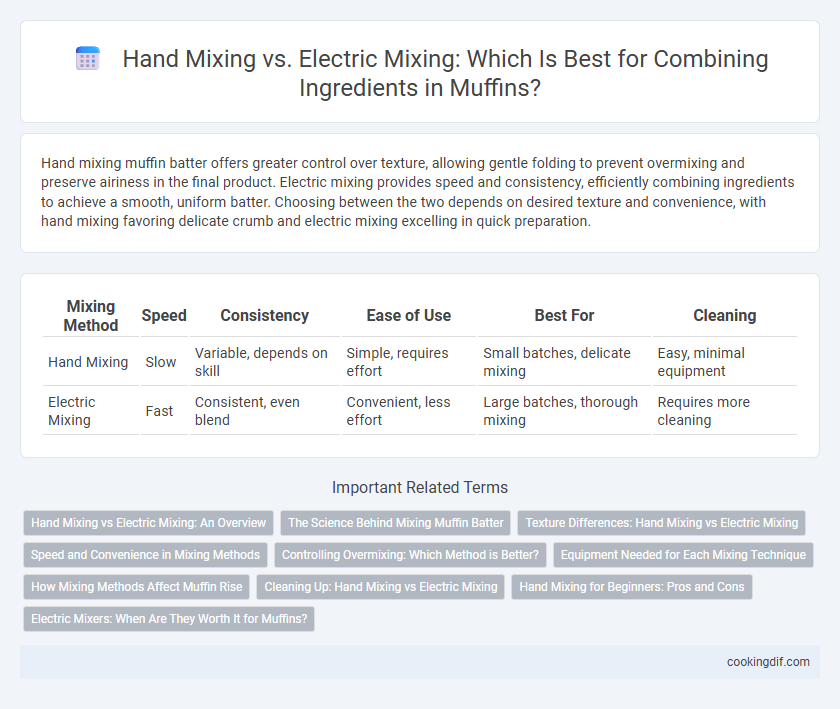Hand mixing muffin batter offers greater control over texture, allowing gentle folding to prevent overmixing and preserve airiness in the final product. Electric mixing provides speed and consistency, efficiently combining ingredients to achieve a smooth, uniform batter. Choosing between the two depends on desired texture and convenience, with hand mixing favoring delicate crumb and electric mixing excelling in quick preparation.
Table of Comparison
| Mixing Method | Speed | Consistency | Ease of Use | Best For | Cleaning |
|---|---|---|---|---|---|
| Hand Mixing | Slow | Variable, depends on skill | Simple, requires effort | Small batches, delicate mixing | Easy, minimal equipment |
| Electric Mixing | Fast | Consistent, even blend | Convenient, less effort | Large batches, thorough mixing | Requires more cleaning |
Hand Mixing vs Electric Mixing: An Overview
Hand mixing muffins allows for greater control over texture by minimizing gluten development, resulting in tender, moist crumb and reduced risk of overmixing. Electric mixing speeds up the process and ensures even ingredient incorporation but can lead to overworked batter if not carefully monitored, causing tough or dense muffins. Selecting the mixing method depends on desired muffin texture and baker experience, with hand mixing preferred for delicate results and electric mixing favored for convenience.
The Science Behind Mixing Muffin Batter
Hand mixing muffin batter provides gentle incorporation of ingredients, minimizing gluten development to create a tender crumb. Electric mixing, while faster, risks overmixing, which activates too much gluten and results in a tough, dense muffin texture. Understanding gluten formation and aeration is key to choosing the appropriate mixing method for optimal muffin quality.
Texture Differences: Hand Mixing vs Electric Mixing
Hand mixing muffins results in a denser, more textured crumb because it gently combines ingredients without overdeveloping gluten. Electric mixing incorporates air more efficiently, producing a lighter, fluffier texture but can risk overmixing, leading to a tougher crumb. Optimal muffin texture often depends on controlled hand mixing to balance tenderness and crumb structure.
Speed and Convenience in Mixing Methods
Electric mixing offers superior speed and convenience compared to hand mixing, significantly reducing preparation time when combining muffin ingredients. Hand mixing requires more physical effort and often leads to uneven batter consistency, which can affect the texture of the muffins. Electric mixers ensure thorough and consistent blending, ideal for achieving uniform muffin batter quickly and efficiently.
Controlling Overmixing: Which Method is Better?
Hand mixing offers superior control over the batter's texture, reducing the risk of overmixing by allowing you to stop as soon as ingredients are just combined. Electric mixing, while faster, can easily lead to overdeveloped gluten in muffin batter, resulting in dense and tough muffins if not carefully monitored. For optimal muffin texture with minimal risk of overmixing, hand mixing is generally the better method.
Equipment Needed for Each Mixing Technique
Hand mixing requires basic equipment such as a sturdy mixing bowl, a wooden spoon or rubber spatula, and optional measuring cups, providing simple tools for manual blending. Electric mixing demands more specialized equipment, including an electric mixer--either handheld or stand mixer--with multiple speed settings and beaters designed for efficient and consistent combining of muffin ingredients. Choosing between hand or electric mixing depends on the availability and preference for simplicity or speed in the muffin preparation process.
How Mixing Methods Affect Muffin Rise
Hand mixing muffins typically results in a tender crumb due to minimal gluten development, preserving the light rise essential for muffin texture. Electric mixing, while faster, can overmix the batter, causing excessive gluten formation that leads to denser, less airy muffins. Controlling mixing time is crucial as overmixing with electric tools often diminishes rise by creating a tougher structure.
Cleaning Up: Hand Mixing vs Electric Mixing
Hand mixing muffin ingredients results in fewer utensils and less equipment to clean, generally requiring only a bowl and a spoon or whisk, making cleanup quick and straightforward. Electric mixers, while efficient for blending batter thoroughly, involve multiple detachable parts such as beaters, bowls, and motor housings that require careful washing and drying to prevent residue buildup. Choosing hand mixing simplifies post-baking cleanup and reduces the need for extensive drying time, ideal for quick muffin preparation.
Hand Mixing for Beginners: Pros and Cons
Hand mixing muffins allows beginners greater control over ingredient incorporation, preventing overmixing that can lead to tough, dense texture. This method requires minimal equipment, making it accessible and cost-effective for novice bakers. However, hand mixing is time-consuming and may result in uneven batter consistency compared to electric mixing, which ensures faster and more uniform blending.
Electric Mixers: When Are They Worth It for Muffins?
Electric mixers offer consistent speed and thorough blending, ensuring muffin batter achieves the ideal texture without overmixing. For large batches or frequent baking, electric mixers save significant time and reduce physical effort compared to hand mixing. Investing in an electric mixer is worthwhile when precision and efficiency in muffin preparation are priorities.
Hand mixing vs Electric mixing for combining ingredients Infographic

 cookingdif.com
cookingdif.com